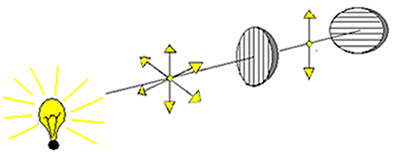Wave polarization is the phenomenon in which a transverse wave, vibrating in various directions, has one of its vibration directions selected, while vibrations in other directions are prevented from passing through a device, called polarizer.
Polarization is a phenomenon unique to transverse waves and cannot occur with longitudinal waves. Thus, light waves, which are transverse, can be polarized, unlike sound waves, which are not polarized, as they are longitudinal.
Sometimes a second polarizer is used to confirm the polarization of the first: it is called analyzer. If a second polarizer is placed so that it polarizes in a direction perpendicular to the first, the wave is prevented from propagating and they are then said to be crossed.
As we said earlier, light is a transverse wave, so we can say that it is emitted in all directions. Therefore, their electric and magnetic fields are produced in all directions, but these fields are always perpendicular to the propagation direction. Let's see the figure below:

In the figure above we see that when the wave passes through the first polarizer, it propagates in only one direction. So in this case, we say the wave was polarized.
If, in a second moment, we add another polarizing material whose slits are arranged perpendicularly to the direction of propagation of polarized light, we will see that such waves do not cross the crystal. Therefore, we can say that polarization is a property of transverse waves.
By Domitiano Marques
Graduated in Physics
Source: Brazil School - https://brasilescola.uol.com.br/fisica/polarizacao-ondas.htm
